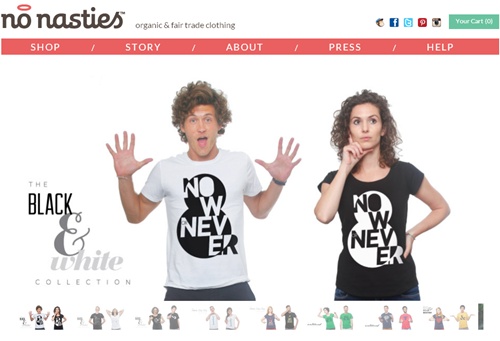A New York techie returns to aid Indian organic cotton farming
26 Jul 2014
 How and when did the concept of 'No Nasties' come about?
How and when did the concept of 'No Nasties' come about?
No Nasties was launched about three years ago, though the idea for it came nearly five years before that. I had read about the number of farmer suicides in India. and used to wonder how to get involved and prevent these suicides. At that point in time I was in a technology career in New York. Eventually it reached a point where I thought it was high I did some thing decided to create an organic brand focussed on India.That's how No Nasties evolved.
We were doing something serious and heavy, dealing with something like famer suicides. But, when we were getting people involved, we could not make them feel as though they had to carry a heavy burden. I thought the best way to get people involved was to do something fun, cool and right. So we decided our brand had to be something attractive, yet with a deep meaning underneath. We thought of different ideas for brand names and the theme of clean, 'no nasties' kind of stuck. That's how we came up with the name.
Could you tell us a bit about your background and prior professional ventures before embarking on this entrepreneurial journey?
My background is in technology. I am an engineer and that runs in our family as both my father and brother are engineers. I studied computer engineering in the US, worked for 12 years as a software programmer and then as a product development manager for different start-ups and large Fortune 500 companies.
This is my first venture. I never thought I would actually start my own company. But it's funny how things work. It's just been a little over three years and we need to do a lot more and grow larger.
As an entrepreneur, how difficult was it to build the brand equity of No Nasties? What were the challenges you faced?
We were a small start-up with very limited funding. We didn't have that kind of money to go buy large advertising space. The best way for us was to bank on customer loyalty. We ensured that we were passionate about what we're doing. So making that emotional connect was the key factor.
This helped in finding our niche in the market in terms of organic cotton. And we started meeting people in places like the farmers market where people were already in tune with our thinking. Just the value for ethics behind the brand was not enough; we gave them a good product of a 100-per cent organic T-shirt. We just continuously kept proving to our customers that this was something real and genuine and not a ploy to make quick bucks.
This was an initiative started to help in prevent farmer suicides. How far do you think you have succeeded?
We are just a small drop in the ocean as a small brand. Cotton farming in India is huge. But the good thing is that we are creating more awareness as more brands are already following into our footsteps.
Whenever we go to meet these farmers, they are pleased that someone is finally doing this in India. Earlier it was mostly foreigners who would come to purchase organic cotton. What they ask of us is that we should buy what is right. From my part, the direct impact I see is that every time we buy from these farmer groups, they get about 20 per cent-30 per cent on an average which is a good thing.
 How different is an organic cotton T-shirt from a regular cotton T-shirt?
How different is an organic cotton T-shirt from a regular cotton T-shirt?
I think that the basic difference starts from the fact that a regular cotton T-shirt is made from cotton that uses a lot of fertilisers. And the manufacturing process itself has a lot of heavy metal dyes. While as a consumer you wear cotton thinking it's nice, soft and cool, it just doesn't breathe. Today it feels like plastic to me.
I cannot wear another T-shirt brand comfortably. Organic T-shirts offer different benefits from different perspectives. From the planet perspective it involves using healthy soil. From a social perspective it benefits the farmers as it involves lower risk and leads to more sustainable farming.
Finally the consumers says they find them comfortable as they run marathons wearing them. They certainly wouldn't do that if the T-shirt wasn't breathing properly or not cool enough.
How does the supply chain in No Nasties work? What is the pricing of a T-shirt like?
We actually buy from factories or multiple farmer groups. There are no middlemen involved. The entry in the supply chain is always audited and it's more transparent. So we can see everything right up to where the farmers actually give me the cotton, which I think is fantastic.
As far as pricing is concerned, we sell our T-shirts between Rs599 and Rs799. They are priced mid-market unlike the high branded expensive T-shirts you. What you get for this quality is amazing. And, it is sheer value for money.
You have come up with some interesting and innovative designs. Are they based on any particular theme? How often does one see new designs coming out?
What we try to do is that instead of the brand having a theme or a concept, we have design diversity. So we work with multiple designers and try to showcase their work. It ranges from doing some hand sketches, photography to graphics. As long as we are able to connect with the consumer, we are flexible with anything. We also customise T- shirts for our clients, which is a big part of our business.
We do T- shirts for events, schools, NGOs, companies and for anyone who wants to support this movement.
We are also planning to launch a wide array of products like tank tops, polo shirts, dresses and baby clothing besides the T-shirts. This is in the pipeline and the prints will be out every 2-3 months.
How can one buy a No Nasties T shirt? How accessible is to customers within and outside India?
The best way is to buy them is through our website www.nonasties.in. It's easy, straightforward and it's the best place to read about what goes into the making of No Nasties T- shirts.
Once the customer makes the purchase, we send it out right away. Delivery within India takes about two - three days and about seven to 10 days for overseas orders. Sometimes it becomes difficult to find the perfect fit while purchasing online.
In instances where the customers are not too happy with the fit, we ensure that we either refund or exchange their order with another purchase. We have no hassles with refunds or exchanges as long as we keep our customers happy.
Having started out as a socially sensitive concept, have you tied with NGOs to spread the awareness of the No Nasties brand?
We have a lot of collaborations going on. There are a few NGOs in Mumbai who support us and we make T- shirts for them as well. For instance there is 'Unlimited India'. We work with realty gigs which do Dharavi tours and work with the Dharavi community.
We work with 'Aatma which is an amazing NGO with a focus on education. Besides NGOs, we also work with other T- shirt and clothing manufacturers. Last year we got together with a few other brands - all focussed on eco-friendly and green products. We launched something called 'Green people of India' and we focused on working together to create more awareness.
Lastly, what are your future plans?
There are a few things we want to do. We want to progress from a T-shirt company to an organic clothing brand, which offers a lot more products.
We want to take 'No Nasties' global. We are working at partnerships around the world to spread the awareness of organic cotton much more.
We also want to focus more on the movement. Our venture for 'No Nasties' was to create a consumer movement for ethical fashion. On that front we have a few different projects going on.
We have direct contact with two groups of farming communities in Maharashtra. We are working on an empowerment and livelihood project with them. We want to get more people aware of what's happening around the country and to support the change even if they don't buy our product.






























